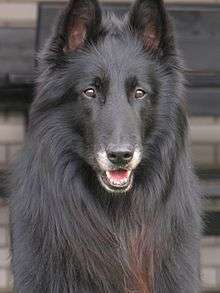Groenendael dog
The Groenendael (in English, approximately /ˈxruːnəndɑːl/) is a variety of dog that is included in the Belgian Shepherd breed, but sometimes treated as a distinct breed. The Groenendael is recognized, either as a breed or a variety of the larger breed, by all major kennel clubs, such as the Kennel Club of the UK.[1] In the American Kennel Club, it is called the Belgian Sheepdog,[2] a term otherwise synonymous with Belgian Shepherd Dog more broadly. This breed is missing an optic chiasm, which surprisingly, shows no visual field deficits. It is identified by a specific eye movement that also occurs in people with a cut optic chiasm.
| Groenendael (Belgian Shepherd Dog) | |||||||||||||||||||||||||||||
|---|---|---|---|---|---|---|---|---|---|---|---|---|---|---|---|---|---|---|---|---|---|---|---|---|---|---|---|---|---|
 | |||||||||||||||||||||||||||||
| Other names | Groenendael shepherd, Belgian Groenendael; AKC: Belgian Sheepdog | ||||||||||||||||||||||||||||
| Origin | Belgium | ||||||||||||||||||||||||||||
| |||||||||||||||||||||||||||||
| |||||||||||||||||||||||||||||
| Dog (domestic dog) | |||||||||||||||||||||||||||||
Description
Like all Belgian Shepherds, the Groenendael is a medium-sized, hard-working, square-proportioned dog, in the sheepdog family.[2] The Groenendael is recognized by its distinctive black coat.
Appearance

The Groenendael should be athletic, strong, imposing, rustic, and balanced in appearance. It should look natural, never as though it has been prepared just for the show ring. Its coat should be profuse, but never look as though it would inhibit the dog's working ability in any way. The colour is always black, with sometimes small white markings being allowed on the chest,chin and feet. Floppy ears are considered a fault when showing. When being shown, its handler should never have to force it into position; ideally the handler should not have to touch the dog at all.
Size
The Groenendael should be 60–66 centimetres (24–26 in) at the withers for males, and 56–62 centimetres (22–24 in) for females. The weight should be approximately 25–30 kilograms (55–66 lb) for males, and 20–25 kilograms (44–55 lb) for females.
Coat
The Groenendael has a thick, double coat. The texture should be hard and dense, never woolly, silky, frizzy, fine, or wiry. The undercoat should be thick and profuse. In conformation shows, dogs without an undercoat are heavily penalized.
Temperament

The Groenendael is intelligent, active, loyal and quietly affectionate. Groenendaels are not a breed for the faint of heart. However, for those who have plenty of time, energy, confidence and love, they are wonderful friends. Training and socializing is essential. They are wary of strangers and protective. They love children as long as they are introduced to them at an early age. The Groenendael bonds deeply to its people and cannot live outdoors or in a kennel. It needs to spend time with its family every day and may experience separation anxiety if left alone for long periods of time.
Care
The Groenendael needs a large amount of exercise as a rule. Expect to spend about two hours a day working with it. Exercise should include not only a walk, but also a training session to keep the dog mentally stimulated. These dogs have great "work ethic" and need a job to do, such as obedience, flyball, schutzhund training, dog agility or livestock work in order to be happy. They are a sensitive breed and cannot be trained using harsh training methods. They do not need much grooming, however when shedding (which happens once or twice a year) they lose massive amounts of coat and need grooming every day.
Health
Activities
Belgian Shepherds can compete in dog agility trials, obedience, showmanship, flyball, tracking, and herding events. Herding instincts and trainability can be measured at non-competitive herding tests. Groenendael exhibiting basic herding instincts can be trained to compete in herding trials.[3] One of the traditional uses of the Belgian Shepherd was guarding the flock. This makes the Belgian shepherd extremely useful for protection purposes. The Malinois is famous as a police-dog, but the Groenendael can also be used in this way.
References
- "Belgian Shepherd Dog (Groenendael)". TheKennelClub.org.uk. London: The Kennel Club. Retrieved 28 November 2013.
- "Belgian Sheepdog in AKC". AKC.org. American Kennel Club. Archived from the original on 8 July 2008. Retrieved 25 June 2008.
- Hartnagle-Taylor, Jeanne Joy; Taylor, Ty (2010). Stockdog Savvy. Alpine Publications. ISBN 978-1-57779-106-5.